Rehumanising the Self-Checkout Experience
How human - centred design approaches can address mistakes, misuse and theft at SCO, drive brand loyalty and create better experiences for staff and customers
Table of Contents:
- -
- Foreword and Acknowledgements
- Executive Summary
- - ECR Retail Loss SCO Design Challenge 2023
- - User-Centred Design and Pathways for Future Research and Development
- Rehumanising the Self-Checkout Experience
- - Introduction
- ECR Retail Loss Design Challenge 2023
- Design Responses
- Pathways for Future Research and Design
- - Practice Pathways
- - Conclusion
- -
- - Situational Crime Prevention
- - Situational Crime Prevention Strategies
- - 19 SCP Techniques for SCO
- - 11Ds – Reducing Crime from the Offender’s Point of View
- - Design Research and Report by
- - Design Research Team
- - Design Against Crime Research Lab
- - Disclaimer
- - About ECR Retail Loss
- - Against Crime Research Lab (DAC)
- - About BA (Hons) Product and Industrial Design
Foreword and Acknowledgements
The adoption of self-checkout has been rapid, and is set to grow in grocery stores, where for many, the self-checkout machines will represent over 50% of all transactions, and beyond, in retail channels such as drug, fashion and home improvement. However, the implementation of self-checkout has its challenges, which can lead to losses and frustrated shoppers.
In our second collaboration with Central Saint Martins, University of Arts London, we tasked their design students to find new design ideas that address these frustrations and reduce losses.
We could not be more delighted with the results of this collaboration and are proud to not only share the five design ideas but also the rationale and principles for these designs.
As with all ECR reports, we never prescribe “solutions” but more, we promote new ways of thinking, principles, and frameworks that retailers can take from the report and use to generate discussion and new thinking in their business, where the five design ideas in this report can be the inspiration.
I would like to thank the academic team for carrying out this research and the retailers who helped contribute to the thinking and the findings presented in this report.
As with all the research undertaken on behalf of ECR Retail Loss, it would not be possible without the active support and involvement of the retail community and the many employees who generously gave their time to participate in the most meaningful of ways. Thank you for taking the time to share your thoughts and experiences.
Finally, can I encourage you to not only read and share this research, but also take part in the work of ECR Retail Loss – further details can be found at: www.ecrloss.com.
Executive Summary
ECR Retail Loss SCO Design Challenge 2023
The ECR Retail Loss SCO Design Challenge 2023 is a collaboration between ECR Retail Loss, Design Against Crime (DAC) and the BA (Hons) Product and Industrial (BAPID) course at University of the Arts London: Central Saint Martins. From February 2023 to June 2023, the undergraduate designers (hereafter, designers) applied human-centred design (HCD) approaches to develop innovative product, user-experience and service design proposals that might drive SCO usage, reduce retail losses, and improve SCO experiences for SCO staff and customers alike. This report offers a comprehensive exploration of how the synergy between HCD, crime science and retail staff insights can forge a new frontier of possibilities, elevating self-checkout experiences and retail engagement.
Design Responses
MyCheckout
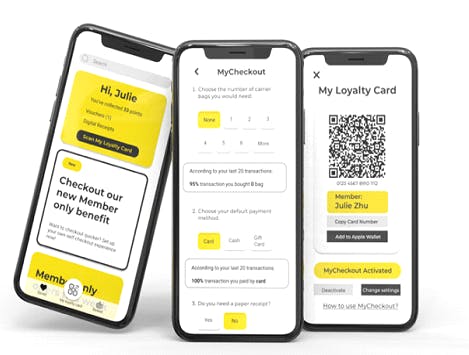
Personalised Self-Checkout Experience
A loyalty system that is tailored to each customer's preferences, ensuring familiarity, speed, and ease. By customizing settings such as bagging options, payment methods, and screen UI/UX via a dedicated app, the customer's choices are saved to their loyalty card. At SCO, a simple scan of the loyalty card instantly configures the machine to the customer’s default setup. No more navigating menus or selecting options, just a seamless, efficient process that it tailored to your needs.
View the MyCheckout video:
Checkout Avatar
![]()
Augmented Reality Surveillance
This system brings a novel twist to surveillance by combining augmented reality (AR) so everyone is disguised through an engaging and friendly customer interface. This design proposal aims to enhance the oversight of Self-Checkout areas while maintaining customer privacy. As shoppers engage with the SCO, they appear as a playful AR avatar overlay on the CCTV screen, transforming routine surveillance into a game-like experience that's culturally sensitive and seeks to mitigate bias.
View the Checkout Avatar video:
Fast & Less Furious
![]()
Interaction-driven Self-Checkout
With "Fast and Less Furious," self-checkout is not just about automation but about enhancing human connections. The design cleverly integrates a barcode system to streamline interventions like ID checks, age verification, and item overrides that typically slow down the SCO process. Instead of navigating through multiple screens, a staff member can simply scan a barcode while engaging face-to-face with the customer (rather than looking at the screen), ensuring that interventions become opportunities for meaningful interactions rather than barriers to efficiency.
View the Fast & Less Furious video:
Reducipe
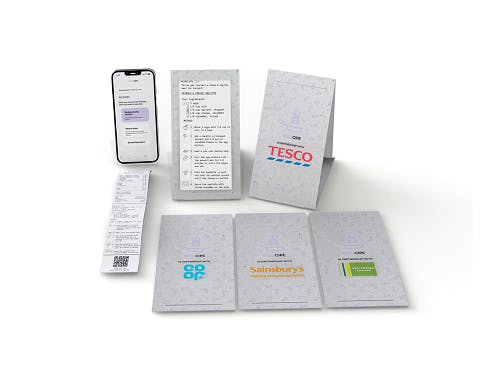
Supporting Customers Through the Cost-of-Living Crisis and
A social-minded proposal designed to enrich the shopping experience with a blend of culinary inspiration and cost-saving strategies. Aimed at supporting customers facing financial constraints, Reducipe ensures a more engaging and honest checkout process. As customers proceed to pay at the self-checkout, the system cleverly analyses their basket contents and displays tailored recipes on the screen, which are then printed on their receipts.
View the Reducipe video:
Ease
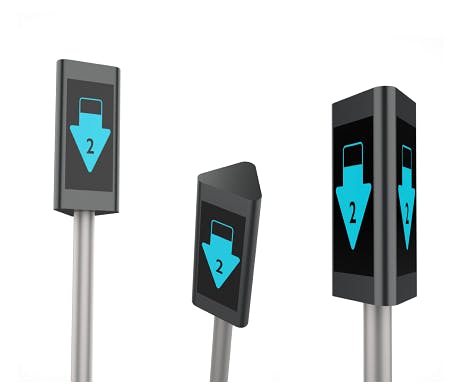
Streamlining SCO with Intelligent Lighting System
A till-lighting system that prioritizes accessibility and efficient staff intervention. Understanding the frustration that comes with waiting for assistance, Ease introduces a lighting system where customers in need are indicated by a distinctive yellow arrow, allowing staff to quickly identify and prioritize help based on the sequence and type of intervention required. This visual cue system uses half and full arrows to differentiate between common issues like weighing scale errors or age verification needs, enabling staff to approach with the right solution in mind.
View the Ease video:
User-Centred Design and Pathways for Future Research and Development
DAC’s analysis of the design proposals identifies strategies and opportunities for innovation in the design of SCO systems and retail experiences that supermarket retailers should consider. We make the case for why these design opportunities have tremendous potential for the future of retail.
The analysis underscores the importance of fostering pro-social behaviours and human interaction, suggesting that a focus solely on preventing negative actions might overlook opportunities to encourage positive shopper experiences. The Fast & Less Furious proposal exemplifies this by enhancing customer-staff interactions, making interventions during checkout quicker and more personal. It highlights the potential psychological deterrent effect of visible actions and identities in preventing retail loss.
Gamification is a means to engage customers and enrich their shopping experience. The use of augmented reality, as seen in the Checkout Avatar proposal, can enhance surveillance without compromising privacy or introducing bias. Moreover, projects like Reducipe suggest that personalised shopping journeys and rewards can increase loyalty and customer satisfaction while providing valuable data for retailers.
The Fast & Less Furious project, again, serves as an example of a low-cost methods, simple prototypes and easily testable design interventions can minimise risks and costs associated with new system implementations. Additionally, the importance of accessibility is underscored with projects like MyCheckout demonstrating how digital applications, like Loyalty apps, can be leveraged to support personalised experiences and create streamlined, thus enhancing the overall shopping experience and fostering brand loyalty.
In summary, these design proposals advocate for a human-centred approach that balances technological innovation with the power of human interaction and accessibility to create a more engaging, efficient, and inclusive retail environment. They also highlight the potential of gamification and personalization in fostering loyalty and enhancing the shopping experience, while underscoring the practicality of using existing technologies to implement cost-effective solutions.
Rehumanising the Self-Checkout Experience
Introduction
Self-checkout (SCO) is a familiar feature in the retail landscape. Supermarkets introduced the first built-in self-scanning machines 40 years ago in 1986, marking the inception of this innovative technology (Myersohn, 2022). Today, despite substantial technical advancements, SCO remains a nuanced and complex challenge within supermarkets and other retail sectors.
A recent survey by ECR Retail Loss of global SCO providers found that two-thirds (66%) of retail respondents expressed worries about the increasing impact of SCO-theft related issues on their businesses, among other challenges (Beck, 2022). 2023 has been called “Year of the Shoplifter” by tabloid newspapers. Adverse economic and social contexts have impacted customers and created challenging retail environments. Problems compound as law enforcement is either unresponsive or not able to adequately deal with the problems identified. For example, research from Monash University, Australia has indicated that one in four shoppers think that shoplifting is justified or recognise that consequences for shoplifting have been downgraded and are not likely to lead to prosecution. No wonder many stores find themselves “at risk” to high rates of crime and vulnerability. Some have embraced what Emmeline Taylor (2023) of City University of London describes as “fortress mitigation” strategies in some of the industry’s most challenging stores. Some key principles are outlined in Taylor’s recent report for ECR Retail Loss, aimed at reducing crime. Additionally, Paul Ekblom’s crime prevention principles, found at the end of this report, also offer helpful strategies to those retailers who need inspiration, to design out theft, where possible.
Significant growth in SCO deployment is anticipated globally before 2030 (Grand View Research, 2022). Given the challenges and frustrations SCO often provokes, it remains an area ripe for innovation through design, which seeks to apply disciplined creativity to resolve conflicting requirements. Yet while the expansion of SCO machines in stores is predicted to continue, we believe the true challenge ahead will lie in taking measures to reduce theft and errors by users whilst at the same time, building customer loyalty and trust. Balancing high customer satisfaction whilst maintaining operational efficiency, remains a complex and tricky challenge. Fortress aesthetics and strategies may not always be appropriate because most customers who are law-abiding as well as staff are put off shopping and frustrated by these heavy-handed security approaches.
So how do we begin to address these aims and objectives?
To reduce retail loss at self-checkout and find opportunities to build trust and loyalty with customers, we adopt a human-centred design approach to understand the end-to-end retail experience of customers and staff. We seek to build empathy for these stakeholders by considering how contextual factors that exist outside of the supermarket, like financial situations or health considerations, might be influencing their decision-making and the overall supermarket retail experience.
Some shoppers, Taylor (2016) points out, are SWIPERS – well-intentioned patrons engaged in routine shop theft and other SCO scams. They intentionally bypass item scanning, knowing they can plead "unintentional error" if caught. Other shoppers avoid SCO altogether, anxious about embarrassment from potential user errors or genuine “mistakes” linked to difficulties operating the machines. Furthermore, the design of SCO spatial layouts, with reduced guardianship and support, often fail to cater to the diverse needs of customers, especially in terms of accessibility or accommodation for senior individuals and those with disabilities or impairments. Attention to lived experience of customers and staff is what should be looked at and considered when designing to improve use and reduce errors, misuse and abuse of SCO. The way the end-to-end service makes customers and staff feel frames how people experience supermarkets and stores and may provoke unintended behaviours, including mistakes and forms of theft like walkaways.
This report acknowledges the strengths of SCO for many customers, such as efficiency and convenience for small purchases, privacy, and reduced labour costs for retailers – benefits that may translate to competitive pricing. However, it also recognises significant problems with SCO that require better design solutions than the ones we have today. It suggests there is value in building customer loyalty, trust and satisfaction and argues for in-depth understanding of the user experiences of customers and staff, and consideration of how new and existing technology might improve the qualitative experience of SCO. Also, how SCO and retail design can innovate by addressing human-centred needs linked to challenges (e.g., social, economic, etc.) that extend beyond the retail environment.
Key issues that impact on negative user experience of SCO include
- Frustration with Technology and Product Restrictions: Machine glitches together with products, like alcohol or certain age-restricted items, that by law require age verification, can cause irritation. Some criminologists suggest people who steal out of frustration regard their behaviour as a justified response and draw upon a range of “neutralization techniques” as a rationale to justify leaving the store without paying for goods.
- Boredom: Scanning and bagging can be monotonous, and when delivered by customers as unpaid labour can breed resentment (and a sense of entitlement to “compensation”). Supermarkets have yet to fully optimize the user experience by acknowledging SCO labour and incorporating offers, promotions and incentives, as part of it. Gamification and entertainment options could also enhance the SCO experience.
- Lack of Personal Interaction: Some customers value personal interaction and assistance. The introduction of Kletskassa or ‘chat checkouts’ by Jumbo Retail Chain in the Netherlands in 2019 to combat loneliness provide slower lanes for customers who would like to chat. It recognises that even efficient automation may not suffice for individuals who seek social engagement.
- Loss of Jobs and Social Redundancy: Concerns about job loss and social redundancy (e.g., jobs replaced by automation) of humans persist among customers. A recent social media circulated post highlights the sentiment that unpaid self-scanning is labour and should not replace cashier roles, especially expressing concern that young people need opportunities for employment, that is being reduced by colonisation of retail space by SCO.
Given there are multifaceted issues associated with SCO – too many to summarise herein and touched upon in our earlier report– ECR Retail Loss commissioned – when our team worked with a group of thirteen product design students to generate alternative design-led solutions to common problems at SCO. Students approached the challenge by employing user-centred and socially responsive design against crime approaches. The objective was to see what design practice could produce in terms of SCO interventions to real world problems. A salient theme emerged from the human-centred design research: that building staff and customer loyalty, satisfaction and trust might help reduce the problems and unintended affordances at SCO that may lead to errors, theft and fraud.
This report shares case studies for five of the student designs to inspire readers to understand new ways of addressing SCO challenges and to reimagine SCO futures. We hope the way these projects have embraced qualitative user research methods may help retail teams draw on the experience of customers and staff to improve their businesses and provide new and exciting pathways for growth and development.
ECR Retail Loss Design Challenge 2023
The ECR Retail Loss Design Challenge 2023 facilitated a collaboration between ECR Retail Loss Network, Design Against Crime (DAC) and the BA (Hons) Product and Industrial (BAPID) course at Central Saint Martins, University of the Arts London. This 2023 project builds on the 2019 self-checkout design collaboration between ECR Retail Loss and DAC, which resulted in a report containing 20 design concepts aimed at driving participation and reducing retail loss at self-checkout. Important to the framing of the 2023 design brief, was ECR Retail Loss’ 2022 research led by Adrian Beck which surveyed over 6,000 self-checkout supervisors and identified several pathways for improving SCO design: guardianship, technology and design of the physical space.
From February 2023 to June 2023, designers applied human-centred design approaches to develop innovative product, user-experience and service proposals that might drive SCO usage, reduce retail losses, and improve SCO experiences for SCO staff and customers alike. To address problems with theft and other forms of error, misuse and abuse at SCO, DAC’s crime and justice design methodology provided concepts, methods and tools for the students to generate designs that were fit for purpose. These Included human-centred approaches and principles from crime science.
The designers conducted design research with major retail partners: Co-op, Sainsbury’s, Tesco, Waitrose & Partners, and NCR. Retail partners generously supported the design process, providing expert interviews and design reviews of student design concepts with retail specialists and store immersion visits.
By expanding on ECR Retail Loss’ prior research and applying the above approaches, the designers generated designs that improve ease of SCO use and anti-crime functionality to build customer loyalty and trust through better user experiences. The benefit of building loyalty to aid crime prevention and reduce retail loss is highlighted in this report’s analysis of the undergraduate design proposals.
This report also offers a comprehensive exploration of how the synergy between human-centred design, crime science and retail staff insights can forge a new frontier of possibilities, elevating self-checkout experiences and retail engagement. The design process we outlined, when complemented by lateral thinking, will enable retail professionals to collectively spark unconventional perspectives and ideate novel strategies. Sideways thinking, with its propensity to challenge conventional wisdom, reframe problems and redefine established norms, belongs to everyone, not just designers, and can serve as a catalyst to unlock innovative pathways, leading to fresh solutions for persistent problems.

2.1 Security Function Framework
For a design to fully address problems and achieve maximum benefit, and to guide implementation and evaluation, it is important to develop and apply a clear logic model to accompany and complement the intuitive side of the design process. One approach to articulating logic models to help generate designs is the Security Function Framework. Drawing on a combination of crime science and design experience, this uses four dimensions to describe proposed or actual designs:
Purpose
What he design (or design feature) is for, and for whom (bo, came, ah easy, Guinn, a, each potentially having different requirements). This also includes what these various stakeholders wish to avoid, e.g, slow transactions, wrongful accusations of theft and other negative aspects of customer experience and/or reputational damage. In this way, crime prevention purposes can be combined with wider requirements.
The leading student designs described in the next section of this report can each be understood using the Security Function Framework. Note that the mechanisms are conjectured here – they may or may not be operating in practice in particular contexts. As part of the overview of each of the student design proposals, Paul Ekblom has analysed the design through the lens of this security framework he invented.
Security Niche
How the design fits with other aspects of the ‘security ecosystem’ in the store. Is ito dedicated security product like an anti-theft tag? A secute product (e.g, 100 heavy to steal}? A secured produel? A securing product with some other primary purpose such as processing purchases, bul with an additional security element? The lasts the most relevant to SCO but the others may sometimes apply.
Mechanism
How the design works fo thwart thieves /fraudsters and minimise honest mistakes, whilst supporting and improving legitimate shopping behaviour? Also facilitating all he normal actions of employees. Mechanisms are the detailed, design-specifc realisation of security principles. One way of describing cause-effect mechanisms from the offender's point of view isthe 11 Ds (e.g, Deter, Detect, Discourage, Demotivate), which can be found in the report appendix.
Technicality
Refers to how the design is constructed, and how it operates in practice. A broadly similar approach can be applied to help articulate other, positive, design requirements: e.g, improving customer experience, speeding customer flow.
Design Responses
Out of the thirteen designs produced by the student designers for this project, the report focusses on five designs. The ways they demonstrate how human-centred design approaches and sideways thinking can reframe challenges into innovative and viable design opportunities. In some cases, the design innovation extends beyond SCO, with designs that boldly consider how retail can help address larger social challenges.
The student designs were presented at the ECR Retail Loss SCO Design Challenge 2023 event held at Central Saint Martins in June 2023, where over 50 retail experts representing retail companies internationally, gave feedback and voted on the top designs. The top five design proposals are summarised in this section of the report. In addition, each design is analysed through the lens of the security function framework and retail specialist feedback from the event has been highlighted.

![]()

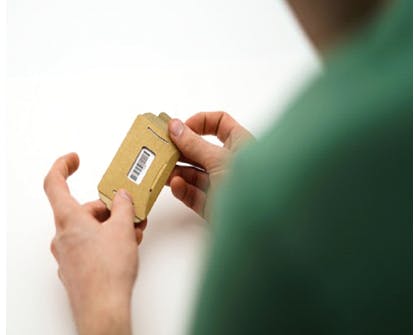
MyCheckout
The MyCheckout proposal is designed to create bespoke experience for SCO users that is far more user-centric, by creating a loyalty system that has simple, clear and customisable settings (adaptable by the customer themselves) that speed up checkout times, deliver personal messages and remember the users' preferences as a way of fostering loyalty through familiarity, speed and ease.
Customers can personalise their checkout preferences in advance on the app, with options including bag preferences, payment methods, and screen UX/UI display settings. These customised settings are then saved onto the customer's loyalty card as the default configuration. When customers scan their loyalty card at the beginning of the self-checkout process, the system links to their account and automatically sets up the self-checkout machine based on the previous settings. Customers can skip selecting the checkout option for future transactions, making the self-checkout experience more efficient and tailored to their needs.
Security Function Framework Analysis.
Purpose - Reduce theft and other loss whilst improving customer experience.
Security niche - A securing procedural environment, primarily for boosting loyalty but with consequential security benefit.
Mechanism - Storing and reapplying customers’ checkout preferences works by 1) fostering loyally and 2) easing the checkout process; together, these reduce motivation for theft and provocation for abusing the system.
Technicality - Customer checkout preferences entered on phone opp and saved on loyally card; applied by default on each checkout occasion.

Retail Specialist Feedback
“In 2025 changes to regulations on digital equipment is coming and it is wide reaching. This is a positive way of doing that.”
“We just launched a large online platform. There's the possibility of using everything that is saved on your Loyalty setting also as an online option. A design like this would promote the online channel. I see this as something we should aim for as I see this as the next logical step — to launch something like that. We are quite big on Loyalty, What we know in terms of shrinkage is that our Loyalty customers produce less shrinkage.”
Checkout Avatar
The Checkout Avatar system aims to enhance natural surveillance of the SCO area through greater customer participation and awareness of surveillance systems. It also aims to address biases in surveillance and crime prevention by protecting the privacy and identity of customers. The surveillance is focused on customer actions rather than their appearance.
The design uses augmented reality (AR) technology within the self-checkout area to gamify surveillance. Within the SCO area, a large CCTV screen will show the live recording of the SCO space. As customers enter the self-checkout area, the image on the screen is augmented to show customers with playful, non-biased and culturally sensitive avatars mapped over their faces, protecting their identity. This playful intervention adds entertainment and increases visibility of CCTV for customers, staff and security, which makes abuse and theft a riskier decision.
Appearing on the CCTV screen, certain interactions can be activated by customer behaviour, for example, an animated timer above the avatar’s head could show how long the customer has been at the till. According to retailer feedback at the Design Challenge July 23 event at CSM, some retailers argue there is a direct correlation between time spent at the SCO machine and retail loss, whether from errors or theft.
Security Function Framework Analysis
Purpose - Reduce thf, reduce bias in crime prevention, protect privacy and identiy of customers.
Security niche - A securing IT system, primarily for the purpose of SCO but with security incorporated.
Mechanism - Works by 1) boosting natural surveillance, 2) empowering staff as preventers, 3) deterring offenders, 4) demotivating offenders through self-awareness.
Technicality - Augmented reality representations of SCO customers protecting their privacy whilst making their behaviour more obvious to staff and other customers.
![]()
Retail Specialist Feedback
“For the topics of privacy and GDPR, it’s a nice solution, but also adding friendliness and fun, It’s not punitive, it's not ‘we're watching you'.”
“What I liked about this is it would draw your attention to a monitor... Now that you have their attention, there needs to be some verbiage on the screen that they are being recorded and viewed.”
Fast and Less Furious
Fast and Less Furious is a service and product proposal that facilitates more meaningful, human interactions between customers and staff at self-checkout. As frustration leads to higher rates of shrinkage and human contact impacts honesty and positivity, the project was situated at the intersection of both. It operates on the hypothesis that a system that affords more meaningful interactions – which could be something as simple and humanly fundamental as eye contact – would both act as a soft deterrence and improve overall experience, because the customer feels seen and acknowledged.
The design also utilises a system of barcodes that support the quick execution of three common types of interventions at self-checkout: (1) ID verifications; (2) over 25 identifications; (3) other login actions like item overrides and scale overrides. The design aims to reduce the current screen-heavy dependence during these interventions, and instead uses these interventions as an opportunity for more direct and personal customer-staff engagement. The SCO staff member casually scans the barcode during conversation to verify or approve the action.
A barcode is assigned for each of the three-defined actions and the barcodes themselves can be printed on the existing SCO-tills on standard receipt paper. In addition, the student designed a simple barcode holder the size of a credit card, that adds to the functionality of the proposed barcode system. In theory, unique barcodes could be securely generated for each SCO host at any time, whether on a weekly basis, at the start of each shift or multiple times during a shift., allowing for flexible decisions to be made by individual retailers.
While this design still requires in-store testing, it was intentionally designed to be low-cost, feasible and compatible with current SCO systems and machines to make prototyping and testing easy, low-risk and inexpensive for the retailers to trial.
Security Function Framework Analysis
Purpose - Reduce theft, improve customer experience
Security niche — A securing IT system, primarily for the purpose of SCO but with security incorporated.
Mechanism - 1) improves customer experience by reducing frustration from speedier, more efficient IT interaction, increasing human interaction; 2) Increase deterrence and detection by increased eye contact with staff; 3) empower improved surveillance by staf; 4) demotivate theft by making interaction more personal
Technicality - System of barcodes that facilitate various common host staff interventions in the SCO process.

Retail Specialist Feedback
“The design plays with the sensory organ with the simple raised edge on the barcode holder that helps the employee quickly identify [which barcode they are using] allowing them to keep eye contact and engagement with the customer. That was a simple and genius way to drive engagement differently.”
Reducipe
The Reducipe proposal aims to improve the shopping experience by offering more choices, better value, increased food and recipe discovery, money saved, and supporting customers through the cost-of-living crisis. This innovation is designed to help households with constrained budgets save money so that they are more likely to complete their transaction honestly. The service has two main functions: the self-checkout recipe selection and the eco-friendly recipe holder.
During payment processing at the self-checkout, recipes are displayed on the screen based on the customer’s basket. The recipe is then printed on the customer’s receipt. This interactive element helps keep users' attention on the screen until the end of the checkout process, thereby impacting walkouts by keeping the customer focused on payment process status.
The Reducipe mobile app adds another level of engagement. The customer can scan the reduced section and get novel and preferred recipe suggestions based on current food availability, ingredients and price. Reducipe also suggests recipes using other ingredients available throughout the store.
By providing a variety of personalised recipes based on expiry date, user preference and by using sustainable materials for the receipt holder, Reducipe has been built to offer customers and supermarkets a closer relationship by prioritising affordability, convenience, discovery and sustainability.
Security Function Framework Analysis
Purpose — Improve customer experience and meeting of cost-of-living needs, increase sustainable consumption, reduce walkouts, reduce theft
Security niche - A securing IT system, primarily for the purpose of SCO and helping/improving relations with customers but with security incorporated
Mechanism - 1) Demotivating theft by helping customers reduce costs; 2) deflecting from theft by distraction; 3) reducing walkouts by maintaining customer attention and engagement with SCO process.
Technicality - IT system engages with phone app to supply recipes attuned to customer needs/circumstances

Retail Specialist Feedback
“It takes a completely different lens to how everyone else has looked at [the challenge].”
“When we're talking about intervention, frustrations and aggression against employees, this would be great actually.”
“Mobile shopping could drive usage [for the app]. Especially being able to see what's on the shelf. Regarding personalised self-checkout, linking this to Loyalty apps so that you can add recipes to your wallet would be a great extension.”
Ease
The design proposal, Ease, aims to speed up SCO transactions through a redesigned till-lighting system that improves accessibility (e.g., legibility of signage) and supports staff to efficiently manage checks and alerts.
Alerts like weighing scale issues and checks like age verification are common occurrences in the self-checkout process. These delays in the customer journey can lead to frustration if customers feel that staff are unaware of their required check or alert. With this new lighting system, the customer who requires assistance first is highlighted with a yellow arrow, while different types of interventions are distinguished using half and full arrows. This arrow typology allows staff to be aware of customer’s types of needs before walking over to the till. In addition, this proposal includes an on-screen waiting experience to entertain the customer and provide another touchpoint for the brand to communicate with the customer.
Security Function Framework Analysis
Purpose ~ Reduction of customer checkout lime, improved staff management of checks alerts, reduction of customer frustration/improvement of experience, improved brand communication, and implicily, fewer walkouts, disputes etc
Security Niche - security is only implicit but again, a securing system where conflicts, walkouts and customer infringements are secondary to main SCO function
Mechanism - 1) Empowering surveillance and place management by staff by improved signalling of customer assistance requirements; 2} Reducing customer frustration by betier/more informed staff response; 3) Entertaining customer during wait
Technicality — giving host staff advance warning of customer issves via a visual signalling system at each station; providing on-screen entertainment material during wait

Retail Specialist Feedback
“What was really good is that as a customer you feel recognised. You feel that someone is coming to you. Also, well thought out about the colours, when you consider the accessibility act for people that are colour blind.”
Pathways for Future Research and Design
This section highlights key takeaways from the undergraduate design proposals, research and insights. Our analysis identifies strategies and opportunities for innovation in the design of SCO systems and retail experiences that supermarket retailers should consider, making a case for why these design opportunities have tremendous potential for the future of retail.
Fostering positive social behaviour through human interaction
The design brief for this ECR Retail Loss SCO Design Challenge 2023 was informed by prior ECR Retail Loss research (Beck 2022) which recommended that improving strategies around guardianship, design, processes and technology could have the largest impact on addressing mis-scans, non-scans and retail loss.
![]()
Looking to the near future, for good reason, AI computer vision technologies that can spot retail theft and errors will be adopted at self-checkout and in retail more broadly. Also, through machine learning, this technology will be able to spot mistakes (e.g., mistakenly selecting the wrong type of bread) and abuse (e.g., swiping, barcode switching, etc.) in real-time. Computer vision tech such as this will be effective at what it has been programmed to do – although it will also be more expensive and will require serious effort to eliminate inadvertent social biases introduced, for example, from training data. But the new AI technologies that power such systems and process the data it collects, will be significant and produce useful results that may have additional value.
By focusing on what we want less of – things like deliberate non-scans and mis-scan – from purely a prevention mindset we might get robust security and surveillance, but we risk missing rich opportunities to design for what we want more of, that is pro-social behaviours and positive experiences for well-intentioned shoppers. Positive human interactions that cost less and leverage human psychology to produce and reproduce positive outcomes.
Take the project, Fast & Less Furious (Herbst 2023) as an example of leveraging human interaction to qualitatively enhance the checkout experience, and pragmatically speed up transaction times. By enhancing moments of eye contact and human interaction at self-checkout during checks and alerts, it provides an opportunity for the business to have a one-to-one interaction with its customers. In addition, from research conducted in the ECR Retail Loss and DAC collaboration in 2019 (Gamman & Doruff, 2019), interviews revealed that SCO staff – many old enough to have worked before the advent of SCO tills – miss having the conversations and brief interactions that assisted checkout afforded. They said that they felt awkward at SCO having to stand behind the customers, looking over the customers’ shoulder and then using an SCO screen to coldly execute a task. The Fast & Less Furious design proposal makes the customer-facing role of SCO host literally face the customer whilst reducing intervention times so that the SCO host can manage the checkout area more effectively.
Looking at crime prevention from a psychological perspective, the opportunity for meaningful human interaction could have a preventive effect due to the increased visibility of their actions and their identity that customers would expect from the SCO experience (see crime prevention appendices by Paul Ekbom).
Gamification for entertainment and engagement
Several student projects demonstrate possibilities for the playful use of technology to improve functionality and enhance the quality of shopping and checkout experiences.
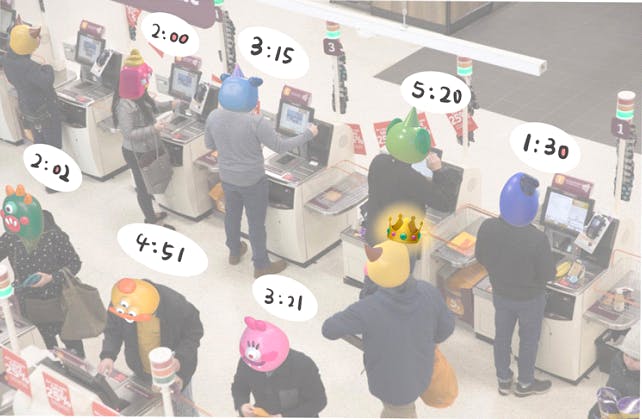
The integration of augmented reality in Checkout Avatar (Bao 2023) presents a compelling opportunity to reshape checkout experiences. By blending the virtual with the physical, retailers can create an engaging and memorable journey that transcends traditional shopping norms. Leveraging AR technology not only drives customer excitement and interaction, but as demonstrated by this project, has the potential to enhance surveillance whilst improving crime prevention strategies by addressing ethical issues of privacy and bias (e.g., racial bias).
‘Target softening’ is a crime prevention technique characterised by subtle and light-touch approaches to security compared to its counterpart technique of ‘target hardening’ (Ekblom 2018). For example, a natural barrier like a low hedge that blends in with the immediate environment rather than a barbed-wire fence creates a less threatening and overtly defensive environment. In the case of Checkout Avatar, checkout surveillance is amplified, but the effect of deterrence is softened by the protective playfulness of the intervention.
As seen by Reducipe (Lulu Lawrence Mills 2023), gamification can further incentivise loyalty programmes and repeat visits, encouraging customers to discover rewards – like new Reducipe recipes. Personalised shopping lists connecting the customer to their specific store, can guide customers through their shopping journey, dynamically highlighting reduced items, recipe ingredients and complementary products. These immersive experiences not only amplify customer satisfaction but also collect valuable data insights, enabling retailers to tailor marketing strategies and optimize inventory management.
Using existing technology and simple prototypes to reduce risk and cost
The average cost of implementing a new self- checkout system of 4 tills was costed by MIT in 2019 at $125,00, with an average life span reported as ten years. We suspect this figure is currently higher, given the rising costs of hardware, software and interior design augmentation. Manufacturers are notoriously cagey about quoting generic prices, perhaps because machines costs are context specific with new interventions, technology and systems of prevention constantly evolving to respond to specific context of use as well as techniques of perpetrators. Anticipating such countermoves is part of the wider approach to 'thinking thief’ as is and updating and implementing technology – specifically hardware – to SCO machine which is both challenging and costly. Such an expensive high-tech terrain also means there is always an opportunity and need for design to offer alternative site specific low-cost and low-tech interventions, to support what is in place.
Taking a human-centred design approach and understanding the SCO and retail experience through qualitative research with staff and customers can help generate insights about what design concepts and interventions are feasible, viable and desired. Researching and developing complex interventions, for example, the design of a new till with computer vision tech, can lead to paradigm shifts over longer timescales. However, to address challenges quickly, a more agile and flexible approach is needed, which requires designing for innovation and easy security upgrades within existing conditions.

The project, Fast & Less Furious (Herbst 2023), utilises existing technology at SCO tills – in this case, barcodes printed on receipt paper – to provide a low-cost and low-effort means to prototype and test the design proposal. Using existing and accessible materials and tech, the student designed this intervention’s physical and digital components to be adaptable and customizable by individual retailers. The Fast & Less Furious intervention utilises existing SCO user interfaces to facilitate the new intervention logic. One of the clear goals of this design was to create a low-cost and flexible prototype that retailers could test and modify without need for extensive development before investment. The accompanying paper pouch that holds the barcode adds marginal cost but complements the usability and functionality of the intervention through its tactile features.
Essential to understanding what interventions are viable and desirable is the quality of the prototyping and testing. Simple prototypes designed well will reduce cost and give an accurate demonstration of use, but most importantly, involving SCO staff in testing and the initial research will help validate (or not) the viability of the design intervention, before incurring the costs of, and commitment to, full-scale production and installation.
Accessibility
Ensuring an exceptional customer experience is pivotal to maintaining a competitive edge and fostering brand loyalty. A fundamental aspect that significantly contributes to this experience is the accessibility of signage and digital applications within the store environment. Accessible design, encompassing both physical and digital touchpoints, caters to the diverse needs of customers and staff, including those with disabilities or special requirements. By prioritizing accessibility, Retailers not only uphold ethical standards but also help an under-served market segment, thereby fortifying customer engagement.

Accessible signage is an imperative for inclusive retail design. Clear, well-placed signs with legible fonts, high contrast and colour friendly palettes to those who are colour blind not only aid those with visual impairments but also assist all customers in swiftly navigating the store layout and locating products. The project, Ease (Yang 2023), applies semiotic research and accessibility research to propose a new lighting/signalling system in the SCO area that supports SCO staff tasks and customer wayfinding. Free and easy to use tools online, like the Colour Contrast Checker (https://colourcontrast.cc/) can quickly verify whether colour combinations meet AA and AAA standards for acceptable contrast.

Moreover, audio cues and descriptive text on signage benefit customers with cognitive disabilities, offering an additional layer of guidance. In tandem with physical signage, digital applications tailored for accessibility amplify customer engagement. Mobile apps with adjustable text sizes, voice commands, and compatibility with screen readers democratize the shopping experience, allowing customers with various disabilities to efficiently locate products and complete transactions. The project, MyCheckout (Zhu 2023), allows customers to personalise self-checkout preferences via the Retailer’s mobile Loyalty app. For example, text sizes, language preferences, and even payment method – which are then displayed at the SCO till user-interface at the time of checkout. Not only does this serve real human-centred needs, but it also contributes to faster and more efficient checkout times. By embracing accessible design principles, supermarket retailers proactively establish an environment that values diversity and empowers all customers, thereby elevating brand perception and loyalty.
The integration of accessibility features in both physical signage and digital applications is of paramount importance for supermarket retailers aiming to provide an exceptional customer experience. Inclusive design not only caters to individuals with disabilities but also enhances the shopping journey for ALL customers, fostering a sense of belonging and ease within the store environment. By embracing accessible practices, supermarket retailers position themselves as industry leaders in social responsibility and customer-centricity, ultimately fostering stronger customer relationships and long-term business success.
Boosting retail success and reducing losses through human-centred customer-centric innovation
In the retail world, ensuring a smooth shopping experience while safeguarding against theft and fraud is generally understood as essential. Retailers have spent years developing various strategies to achieve this dual goal, all with the aim of creating a safer, more enjoyable shopping environment for shoppers. One common approach is optimising store layouts and checkout procedures to reduce error and theft opportunities. For instance, retailers for decades have placed high-value items near the entrance or exit for easy monitoring: electronic tags, sensors, or alarms, manager approvals for discounts, returns, or refunds, and some even use biometric or facial recognition technology to verify customer identities. These strategies may not fully address SCO or the underlying reasons behind retail losses, which often relate to customers' financial and emotional states.
Studies, including a review of shoplifting behaviour, for the International Journal of Offender Therapy and Comparative Criminology (2010), reveals a list of different types of motivations for theft and suggests some individuals may turn to theft as a response to financial loss or emotional turmoil. They may justify their actions by believing they deserve a better deal, or worse think the retailer can absorb the loss, or feel their actions harm no one! Retailers may benefit by anticipating financially challenged customers and helping them to spend responsibly and thus reducing retail losses. The Reducipe proposal is an excellent example of this ethos as a customer-centric response to the cost-of-living crisis. Practical considerations to help achieve outcomes for the collective good include:
- Education and financial guidance
Providing education and financial guidance, such as budgeting tips or savings options helps customers make informed spending decisions. This builds trust, prevents impulsive purchases, and encourages responsible spending.
- Promoting Social and Environmental Responsibility
Retailers can also promote social and environmental responsibility by contributing to charitable causes, supporting local communities or reducing waste and emissions. This appeals to customers' values and encourages them to contribute positively rather than resorting to negative behaviours.
- Creating a welcoming store culture
Retailers can nurture a supportive and inclusive store culture by warmly greeting customers, engaging with them personally and ensuring secure design does not have to look and feel defensive. Take Checkout Avatar as an example of removing or greatly limiting the opportunity for bias. This may create a sense of belonging and gratitude among customers, potentially discouraging some dishonest or disrespectful behaviour.
Win-win for all
By implementing these customer-centric strategies, retailers may not only find new ways to try and reduce some (if not all) retail losses but also enhance customer satisfaction and loyalty. Helping financially struggling customers to feel good about the brand as well spend responsibly creates a win-win situation for both retailers and customers. I's a step toward a more compassionate and secure shopping environment for all.
Practice Pathways
The student designs explore some of many potential research pathways that Retailers can pursue in the design of future products, services and experiences. Here we identify the mindsets and approaches supermarkets should engage with to reduce customer frustration and to improve the odds of producing designs that are viable for business, through finding opportunities for innovation connected to addressing human-centred needs.
For all intents and purposes, we refer to these as ‘Practice Pathways’. These methods and mindsets informed the design approach taken by the undergraduate designers; however, these practices are not just for designers. It is likely that you and your staff are already familiar with these or have incorporated them in previous retrofits. They are sensible approaches and concepts that demand only empathy, curiosity and creativity from anyone wishing to change current challenges into future opportunities.
User-Centred Design, Empathy and SCO: Why UCD approaches are helpful
“Your most unhappy customers are your greatest source of learning."
– Bill Gates
Walking in the shoes of those who use or manage SCO, engaging with what they see, hear and feel, (and what they understand cause triggers for theft), observing how staff and customers interact with machines, objects, systems, services and processes, underlies and contributes to empathic and yet agile user experience design. User experience design involves understanding a person’s perceptions of ease of use, utility and efficiency, and also understanding what makes people feel good. Also, using this information, as well as useful interdisciplinary findings, to generate new ways to improve and enhances SCO product, systems and services.
User-centred design approaches are at the heart of what is called user-experience design and were originally pioneered by Donald Norman and Jakob Nielson in the 1970s linked to the field of Human Computer Interaction (HCI) design which attempted to create better user interfaces. It is a rich discipline, with many authors. User experience design has drawn on Norman and so many diverse authors and research, and thus UX design (user experience design) emerges in the 21st century as a multi-disciplinary approach. One that is concerned with enhancing the overall experience of users. It has generated a whole range of design methodologies drawing on findings from cognitive and social psychology, sociology, ethnography, engineering, ergonomics, aesthetics of form, and raiding many other disciplines to generate new approaches. Also, questions and techniques such as user interviews, design probes and other methods, help design researchers gather data about what is known and needed from existing products, systems and services.
Human-centred design at Central Saint Martins extends the user model and often engages with co-design approaches – designing with as well as for people – to help ensure that design responses are appropriate and fit for purpose. Ultimately, human-centred design offers methodologies that help designers gather data and ensure that the design choices they make are informed by real world needs and align with staff/customers’ user perceptions, emotions and expectations.
The undergraduate product designers whose work is featured, are trained to use research and design methods found in human-centred, service design and user-experience design practices. In addition, the projects have a unique focus on misuse and abuse – methodologies associated with 'thinking thief' mentioned above and by the Design Against Crime Research Lab. The multi-disciplinary and diverse perspectives that the students bring to their design practice are also informed by their own interests, personalities and design know-how.
Sideways thinking
Students were encouraged to widen their lens for viewing SCO, and to take a ‘sideways’ look at SCO challenges. This lateral and creative approach requires taking different perspectives, like the point of view of marginalised users and/or undesirable ones such as adaptive criminals. This gave great insight into ways that Retailers can design and develop new ways that can contribute to social innovation and address crime-related issues.
Sideways thinking also helped the student designers offer new customer service-focused design outcomes for SCO that had not been imagined before. These ideas in action were positively received by retailers and indicate the potential of design students putting themselves in the position of a different types of employees or users – good and bad actors – including those misusers who are regularly left unaccounted for when designing new systems, services and products.

Conclusion
This is the second collaborative effort between ECR Retail Loss and the Design Against Crime Research Lab at the University of the Arts London. It has built upon the foundation laid during our initial 2019 project, which aimed to combat theft and minimize losses at self-checkout terminals. What sets this project apart is its reliance on Prof. Adrian Beck's extensive 2022 research, which involved surveying over six thousand retail staff to gain insights from their first-hand experiences and identify solutions for self-checkout challenges.
Beck's report highlighted critical territories for design intervention – guardianship, technology, design processes, and spatial considerations – as areas ripe for future development with the potential to make the most significant impact on self-checkout efficiency and retail loss reduction.
But it must be said that the accumulated expertise of the CSM team's design and crime knowledge - with staff specialisms in shoplifting, empathic human-centred design and crime prevention – plus staged advice from retailers and other specialists involved in this project - was also instrumental in informing student design responses. Together we systematically pushed students to find imaginative and fun ways to target issues such as errors, mis-scans, non-scans and other forms of theft, and to identify sources of friction and provocation that affect both staff and customer behaviour and experience.
Among our innovative student proposals, the Reducipe project stands out for its innovative use of technology to address broader socio-economic issues leading to theft and customer dissatisfaction, injecting novelty into the supermarket shopping experience. It not only aims to reduce costs but also surprises and delights shoppers by pairing near-expiry date products with new items and providing enticing recipe suggestions, leading customers to explore exciting new meal combinations. The Checkout Avatar proposal addresses issues of bias, anxiety, boredom, and frustration during queuing, enhancing the overall shopping experience. Additionally, the Fast & Less Furious proposal, with its minimal addition of a paper barcode receipt holder to the self-checkout area, empowers staff as attendants to make eye contact as well as swiftly resolve issues, freeing up more time for personalized customer interactions. Finally, the Ease proposal improves the accessibility of digital and in-store environments to create better interactions for customers, and in the case of MyCheckout, the design’s accessibility benchmarks afford more personalised digitally mediated experiences that boost engagement with the brand.
All the design proposals presented in this report share a common objective: to foster a stronger sense of connection between shoppers and the retailers they patronize, with the understanding that this might help reduce theft and error. This enhanced connection, facilitated by staff training as well as by improved digital and physical retail environments and interactions, has the potential to cultivate brand loyalty and improve trust, factors that can significantly impact retail loss.
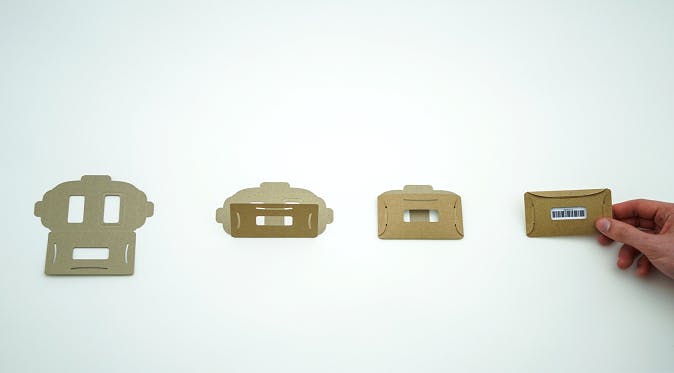
Author Information
Jeff Doruff

Jeff Doruff is a designer, researcher and project coordinator for Design Against Crime Research Lab and also a Stage Lead and Lecturer at Central Saint Martins on the BA (Hons) Product and Industrial Design course. Since 2018 he has worked with Design Against Crime at CSM on projects that involve facilitation of collaborative design practices with diverse participants and stakeholders across public and private sector organisations for the purpose of co-creation, innovation and equitable engagement.
Dr. Lorraine Gamman

Dr. Lorraine Gamman is Professor of Design at Central Saint Martins and Director of UAL’s award-winning Design Against Crime Research Lab (DACRL), which she founded in 1999, to explore how art, design and creative engagement processes can reduce crime. An authority in applied social design practice, she is co-creator of a range of award-winning anti-crime product interventions and online resources that interpret and address offender techniques and utilises creative interventions to attempt to reduce crime.
Prof. Paul Ekblom

As a researcher in the UK Home Office, Paul Ekblom led diverse crime prevention projects. He then spent 10 years as Professor (now Emeritus) at the University of the Arts London Design Against Crime Research Centre. He is also Visiting Professor at the Department of Security and Crime Science, UCL and the Applied Criminology and Policing Centre, University of Huddersfield. Current work covers horizon-scanning, design, and developing knowledge frameworks – for general crime prevention, CPTED, community safety, problem-oriented policing, cybercrime and counter-terrorism. Paul also writes on technology and crime, and crime/terrorism arms races. All Paul’s writings and presentations can be viewed at https://crimeframeworks.com.
Adrian Allen

Adrian Allen is a Stage Leader and Lecturer at Central Saint Martins on the BA (Hons) Product and Industrial Design course. He has led design, development and delivery for companies across diverse product sectors including gifts, medical, kitchen, bathroom, luxury homeware, lighting and electronics.
Crime Science Review
Situational Crime Prevention
A framework for developing and evaluating designs from a security and crime science perspective
Crime Science has developed many frameworks to help practitioners (in the present case, designers and store managers) generate proposals for security interventions. As far as possible these are evidence-based, theoretically and practically plausible and suited to the problem and context, whether at the level of individual store sites or across sites or regions at company level. Though we applied several crime prevention frameworks in the generation of design concepts, as set out in the main text of this report, in this Appendix we focus on the foundational principles and techniques of Situational Crime Prevention. The aim is to give the designers and managers of SCO facilities a broader understanding of what a human-centred approach can offer, and in so doing to boost their capacity to combat retail loss whilst simultaneously augmenting the customer and staff experience. Further Crime Science frameworks can be seen at https://crimeframeworks.com/list-of-frameworks/. We have already presented the Security Function Framework in the main text and we now offer the attached Table for quick review, followed by a fuller account of Situational Crime Prevention
Situational Crime Prevention Strategies
Situational Crime Prevention (SCP) is a major approach within Crime Science. While conventional criminology focuses on understanding and seeking to influence why and how individuals become criminals, and what motivates them, SCP takes such criminality as a given. Instead, it identifies and focuses on crime problems as distinctive concentrations of criminal events occurring at particular (kinds of) places and times. It aims simply to reduce the likelihood of those criminal events and the harm they cause, by advance action to alter the immediate circumstances in which those events may occur.
Whilst context is vital in terms of understanding how to reduce crime, once perpetrator techniques at SCO are understood, there are five generic prevention strategies that could be used to prevent crime. These include:
- Increasing the effort the offender must make to carry out the crime.
- Increasing the risks the offender must face in completing the crime.
- Reducing the rewards or benefits the offender expects to obtain from the crime.
- Removing excuses that offenders may use to “rationalise” or justify their actions.
- Reducing or avoiding provocations that may tempt or incite offenders into criminal acts.
These five broad approaches have been considered in the student designs and are used to organise the more specific list of 19 Techniques of Situational Crime Prevention for SCO.
19 SCP Techniques for SCO
These can work as prompts for you to consider whether or not the SCO crimes you are dealing with can be addressed in this way, or to inspire entirely new thinking from you to deliver crime prevention.
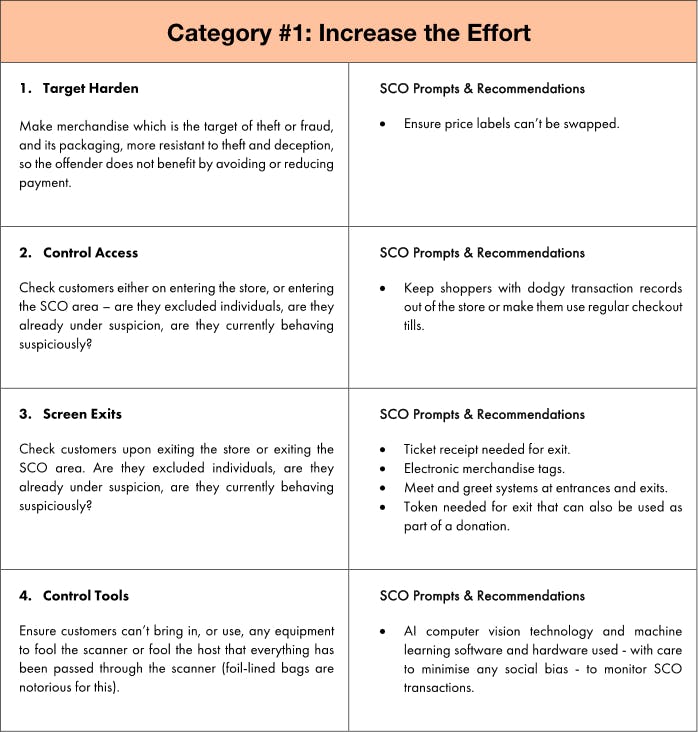
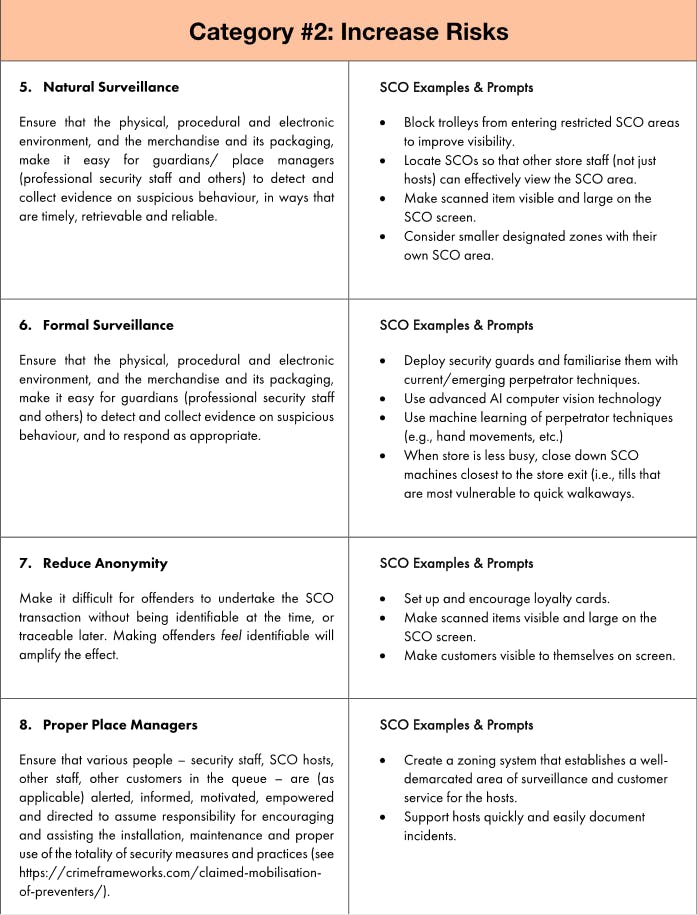
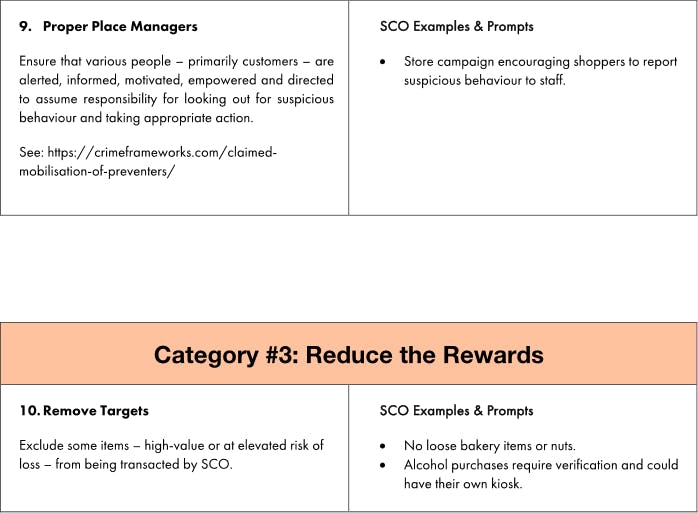


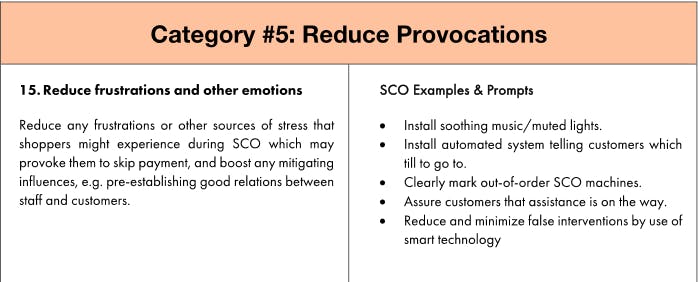
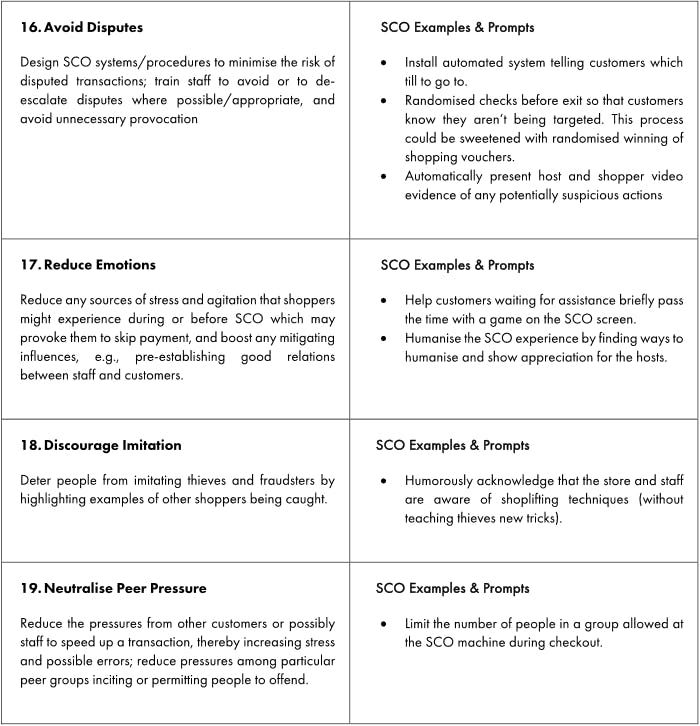
11Ds – Reducing Crime from the Offender’s Point of View
The previous intervention framework emphasises techniques or methods over principles. By contrast, the “11Ds” framework https://crimeframeworks.com/ds-framework/ takes a deeper dive into principles and focuses on how security measures might be expected to have their effect on the offender. The 11Ds framework was developed starting on familiar territory with deterrence and detection, then adding new principles as these became apparent.
Some of the D principles are practical, limiting what perpetrators can do by changing the environment and its contents; others are psychological, changing how perpetrators see, think or feel; others are personal, spotting, identifying, catching, tracking or tracing the perpetrators. Most are an admixture. Some of these will be more appropriate to SCO crime than others.
- Defeat: Physically block access and movement, or block/obscure the information that offenders want to collect about vulnerabilities, security practices, etc.
- Disable/Deny equipment helpful to offenders such as stick-on price labels.
- Direct/Deflect offenders towards/away from a particular place or behaviour.
- Deter-known: let offenders know the risk of detection/arrest/conviction/embarrassment is high, and judge it unacceptable, so they avoid/abort crime attempt.
- Deter-unknown: render offenders uncertain what control methods they are up against, so again they judge risk unacceptable.
- Discourage: make offenders perceive the effort too great and/or the reward too little, relative to risk, so they abandon/abort attempt.
- Demotivate: awaken within offenders, motives/emotions contrary to the mission, e.g., empathy with potential victims, removing excuses, ‘cheat’ self-image.
- Deceive: lead offenders to act on the wrong information on risk, effort, reward, where to go, type of security measure etc., thereby exposing them to detection, frustration, or mistakenly underrating the payoff from targeting this site.
- Disconcert: cause offenders to make overt involuntary movement or otherwise become startled, thereby either aborting the crime or drawing the attention of the host or other security staff.
- Detect: make offenders self-reveal by rendering criminal actions/intentions more distinctively different from honest shopper behaviour; and improving capacity/motivation of people exercising preventer/ responder roles to detect anomalous behaviour.
- Detain: once offenders detected, catch and hold them (or record reliable identifying details so they can be traced).
Design Research and Report by
Design Against Crime Research Lab
Project in collaboration with participating retailers: Co-op, Sainsbury’s, Tesco, Waitrose & Partners, and NCR.
Design Research Team
Jeffrey Doruff, Prof. Lorraine Gamman and Paul Ekbom with Adrian Allen and the BA (Hons) Product and Industrial Design students.
Student work featured in this report: Liyang Bao, Jan Herbst, Lulu Lawrence - Mills, Shuhui Yang, Lizixi Zhu.
Design Against Crime Research Lab
University of the Arts London: Central Saint Martins
© January 2024, all rights reserved
Disclaimer
The research for this report was supported by ECR Relail Loss. The document is intended for general information only and
builds upon the findings of o qualitative survey of industry experts and extensive literature review. Companies or individuals
following any aciions described herein do so entirely at their own risk and are advised to take professional advice regarding
their specific needs and requirements prior to taking any actions resulting from anything contained in this report. Companies
‘re responsible for assuring themselves that they comply with all relevant laws and regulations including those relating to
intellectual property rights, data protection and competition laws or regulations.
The images used in this document do not necessarily reflect the companies taking part inthis research.
© Jonvary 2024 all rights reserved
About ECR Retail Loss
The group is part of the ECR Community, o voluntary and collaborative retailer manufacturer platform with a mission to ‘fulfil consumer wishes better, faster and at less cost’. Over the last 25 years, ECR has acted as an independent think tank focused on creating imaginative new ways to better manage the problems of loss and on-shelf availability across the retail industry. Championing the idea of Sell More and Lose Less, the group is open to any retailer and manufacturer to join. Its work is supported by research funding provided by Checkpoint Systems, Genetec, NCR, Retail Insight and RGIS.
For further information: www.ecrloss.com
Against Crime Research Lab (DAC)
Design Against Crime is a practice-led design research inilalve that emerged at Central Saint Martins. The Lab's focus is based on the understanding that design thinking, as well as design practice, can and should address securiy issues without compromising functionality and other aspects of performance, or aesthetics.
For further information: www.designagainsterime.com
Contact j.doruff@csm.crts.ac.uk & l_gamman@esm.ars.ac.uk
About BA (Hons) Product and Industrial Design
BA (Hons) Product and Industrial Design is a Queens Anniversary Prize-winning undergraduate course recognised for its outward-looking disposition and the creativity and employabilly of its graduates. As part of the Product Ceramic and Industrial Design programme, i's committed to an ethos of creative ambition, collaboration and making through design os a practice that transforms.
Contact: j.dorutf@csm.crts.ac.uk & pcidadmin@csm.arts.ac.ukAppendix
Main office
ECR Community a.s.b.l
Upcoming Meetings
Join Our Mailing List
Subscribe© 2023 ECR Retails Loss. All Rights Reserved|Privacy Policy

